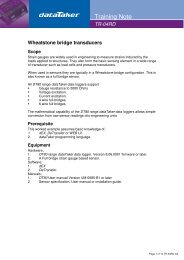Create successful ePaper yourself
Turn your PDF publications into a flip-book with our unique Google optimized e-Paper software.
RP – Poll Memory Slot<br />
RP { slot1 slot2 }<br />
where:<br />
slot1 is the first memory slot to poll (0-150, default:0)<br />
slot2 is the last memory slot to poll (0-150, default:0)<br />
This command will poll memory slots slot1 to slot2 inclusive. If no parameters are specified then Slot 0 is polled.<br />
What does polling a slot mean?<br />
For a passive memory slot (RECV, RECVE, RECVJ or GPS), the most recent received value is formatted and<br />
returned to the host. Alternatively the minimum, maximum or average (calculated since the last poll) may be returned<br />
instead, if the FORMAT clause specifies to do so. If no data at all have been received then no value will be returned.<br />
For an active memory slot (SEND, SENDE, RQST, RQSTJ ), <strong>CANgate</strong> will transmit the required CAN message. In<br />
the case of the request types, <strong>CANgate</strong> will then wait for a response and return the required data to the host.<br />
If no response is received to a request, or if no data at all have been received at the time that a passive slot is polled, then no<br />
value will be returned. If there was text specified in the format string then that text it will still be returned.<br />
If any slots in the specified range have not been defined then they will be skipped (nothing will be returned for the undefined<br />
slots).<br />
Note: When passive slots are polled, the data is returned instantly, while for RQST/RQSTJ slots the data will only be<br />
returned when a response is received from the ECU. This means that if a mixture of "receive" and "request" slots are polled<br />
all at once then the order of responses may not match the order of the memory slots.<br />
Examples<br />
RP 1 150<br />
Poll all defined memory slots.<br />
RQSTJ 2 65226 3 6 FORMAT "%f\n"; RP<br />
SEND 1 0x142 112233; RP<br />
The RP command is often appended when defining an active memory slot in Slot 0. This usage is not applicable to passive<br />
slots because at the point where the RP command is executed it is unlikely that any data has been received since the slot<br />
was defined, so nothing will be returned.<br />
CONNECT – Set CAN Bit Rate<br />
CONNECT CANport bitrate<br />
where:<br />
CANport is the CAN port to use (integer, 1-2)<br />
bitrate is the CAN bitrate in kbps (integer, 0, 10, 20, 50, 125, 250, 500, 1000)<br />
Before a CAN port can be used it is necessary to specify the bitrate using the CONNECT command.<br />
Initially, the bitrate is set to 0, which will disable the port. If the bitrate is set incorrectly, bus errors will result and the port will<br />
be disabled for a period of two seconds, after which <strong>CANgate</strong> will re-attempt connection.<br />
The currently selected bitrate setting is saved to flash memory, so it will automatically be set if <strong>CANgate</strong> restarts following a<br />
power interruption.<br />
Examples<br />
CONNECT 2 250<br />
Configure the CAN port 2 for connection to a 250kbps CAN network. (Note that J1939 based CAN networks always use a<br />
bitrate of 250kbps.)<br />
VERBOSE – Enable Extended Messages<br />
VERBOSE state<br />
where<br />
state is either ON or OFF. Default is OFF.<br />
In Verbose mode, <strong>CANgate</strong> will return error and confirmation messages as required. Also, all received commands will be<br />
echoed back to the host computer. This is useful for troubleshooting.<br />
In Normal (non-verbose) mode, no unsolicited messages are returned to the host. Data values are returned, as is text that is<br />
generated in direct response to a command (eg VERSION). Commands are not echoed.<br />
UM-0086-A2 <strong>CANgate</strong> User’s <strong>Manual</strong> Page 23



